width Lexus GS350 2014 Do-it-yourself maintenance /
[x] Cancel search | Manufacturer: LEXUS, Model Year: 2014, Model line: GS350, Model: Lexus GS350 2014Pages: 844, PDF Size: 10.59 MB
Page 233 of 844

GS350_OM_OM30D41U_(U)
2334-5. Using the driving support systems
4
Driving
■Lane departure warning function
●When the vehicle speed is approximately 30 mph (48 km/h) or
more
●When the lane width is more than approximately 9.8 ft. (3.0 m)
●When driving on a straight road or through a curve with a radius of
more than approximately 394 ft. (120 m)
■Lane keeping assist function
●When the vehicle speed is between approximately 45 and 112 mph
(72 and 180 km/h)
●When the vehicle-to-vehicle distance mode of the radar cruise
control is on, and the set vehicle speed is approximately 45 mph (72
km/h) or more (the function will not operate when the radar cruise
control is in set speed mode)
●When the lane width is between approximately 9.8 and 13.1 ft.
(3.0 and 4.0 m)
●When driving on a straight road or through a curve with a radius of
more than approximately 656 ft. (200 m)
Operating conditions for each function
Page 254 of 844
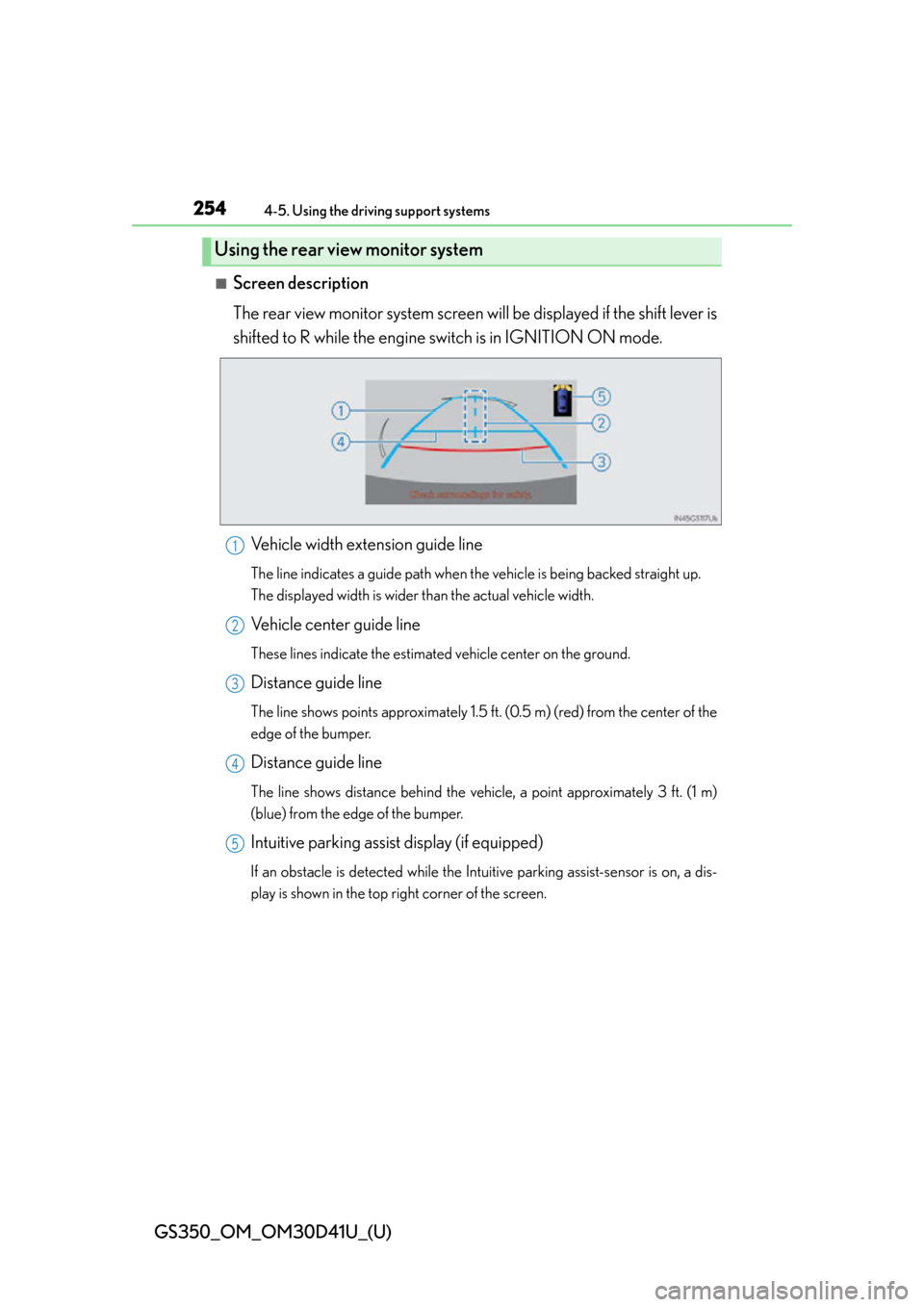
254
GS350_OM_OM30D41U_(U)
4-5. Using the driving support systems
■Screen description
The rear view monitor system screen will be displayed if the shift lever is
shifted to R while the engine switch is in IGNITION ON mode.
Vehicle width extension guide line
The line indicates a guide path when th e vehicle is being backed straight up.
The displayed width is wider than the actual vehicle width.
Vehicle center guide line
These lines indicate the estimated vehicle center on the ground.
Distance guide line
The line shows points approximately 1.5 ft. (0.5 m) (red) from the center of the
edge of the bumper.
Distance guide line
The line shows distance behind the vehi cle, a point approximately 3 ft. (1 m)
(blue) from the edge of the bumper.
Intuitive parking assist display (if equipped)
If an obstacle is detected while the In tuitive parking assist-sensor is on, a dis-
play is shown in the top right corner of the screen.
Using the rear view monitor system
1
2
3
4
5
Page 256 of 844
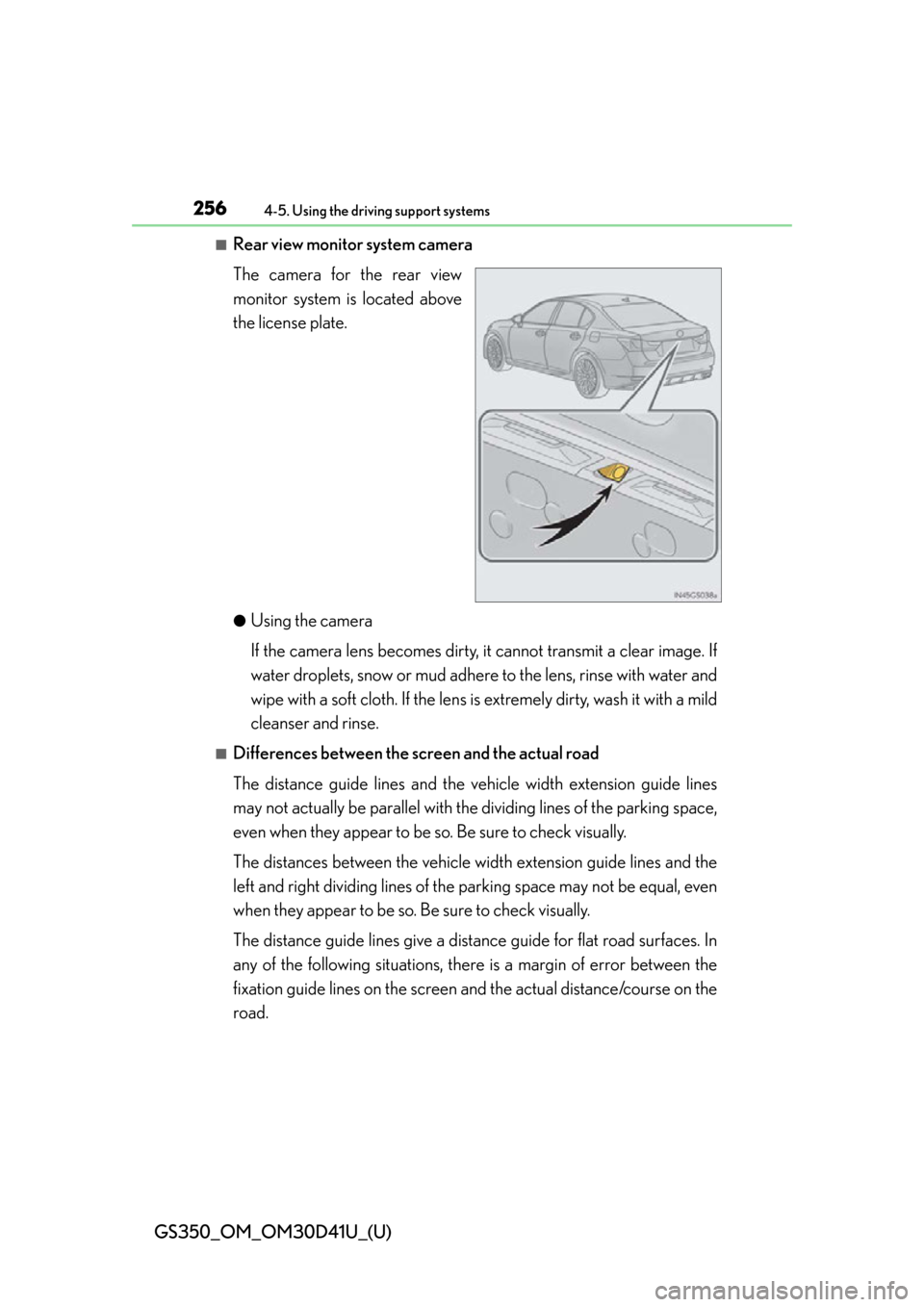
256
GS350_OM_OM30D41U_(U)
4-5. Using the driving support systems
■Rear view monitor system camera
The camera for the rear view
monitor system is located above
the license plate.
●Using the camera
If the camera lens becomes dirty, it cannot transmit a clear image. If
water droplets, snow or mud adhere to the lens, rinse with water and
wipe with a soft cloth. If the lens is extremely dirty, wash it with a mild
cleanser and rinse.
■Differences between the screen and the actual road
The distance guide lines and the vehicle width extension guide lines
may not actually be parallel with the dividing lines of the parking space,
even when they appear to be so. Be sure to check visually.
The distances between the vehicle width extension guide lines and the
left and right dividing lines of the parking space may not be equal, even
when they appear to be so. Be sure to check visually.
The distance guide lines give a dist ance guide for flat road surfaces. In
any of the following situations, th ere is a margin of error between the
fixation guide lines on the screen and the actual distance/course on the
road.
Page 259 of 844
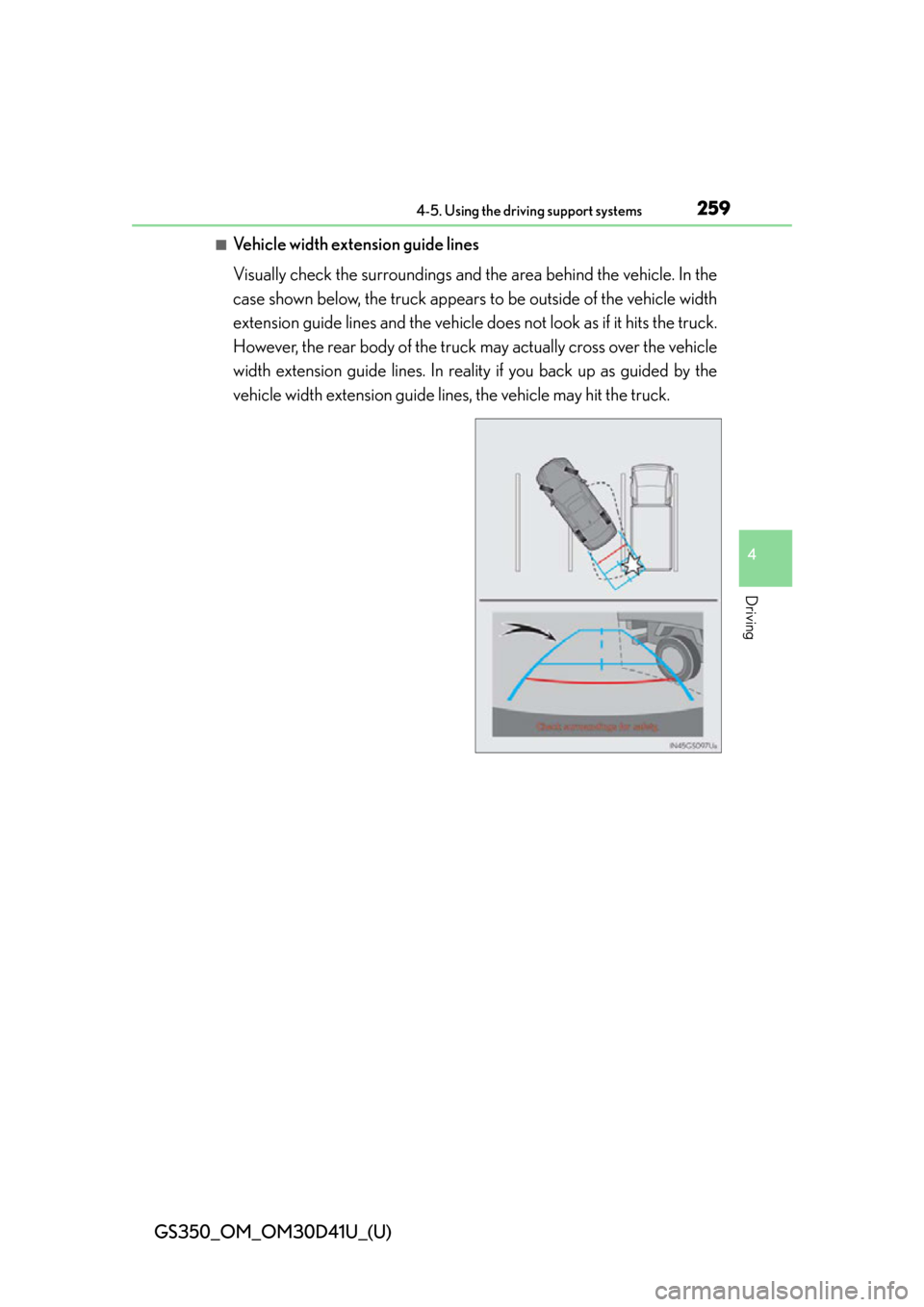
GS350_OM_OM30D41U_(U)
2594-5. Using the driving support systems
4
Driving
■Vehicle width extension guide lines
Visually check the surroundings and the area behind the vehicle. In the
case shown below, the truck appears to be outside of the vehicle width
extension guide lines and the vehicle does not look as if it hits the truck.
However, the rear body of the truck may actually cross over the vehicle
width extension guide lines. In reality if you back up as guided by the
vehicle width extension guide lines, the vehicle may hit the truck.
Page 655 of 844
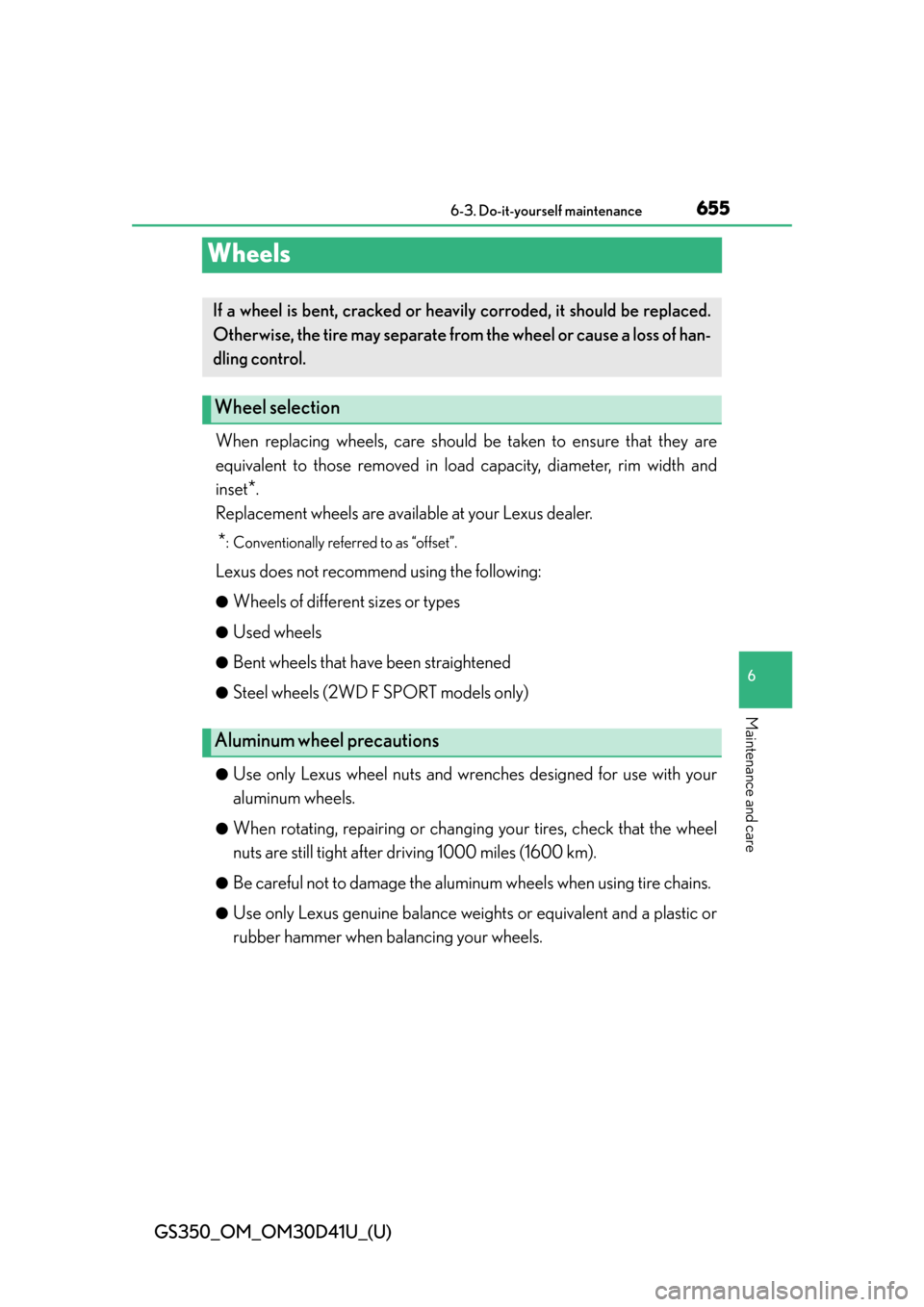
655
GS350_OM_OM30D41U_(U)6-3. Do-it-yourself maintenance
6
Maintenance and care
Wheels
When replacing wheels, care should be taken to ensure that they are
equivalent to those removed in lo ad capacity, diameter, rim width and
inset
*.
Replacement wheels are available at your Lexus dealer.
*: Conventionally referred to as “offset”.
Lexus does not recommend using the following:
●Wheels of different sizes or types
●Used wheels
●Bent wheels that have been straightened
●Steel wheels (2WD F SPORT models only)
●Use only Lexus wheel nuts and wren ches designed for use with your
aluminum wheels.
●When rotating, repairing or changing your tires, check that the wheel
nuts are still tight after driving 1000 miles (1600 km).
●Be careful not to damage the alum inum wheels when using tire chains.
●Use only Lexus genuine balance wei ghts or equivalent and a plastic or
rubber hammer when balancing your wheels.
If a wheel is bent, cracked or heav ily corroded, it should be replaced.
Otherwise, the tire may separate from the wheel or cause a loss of han-
dling control.
Wheel selection
Aluminum wheel precautions
Page 768 of 844
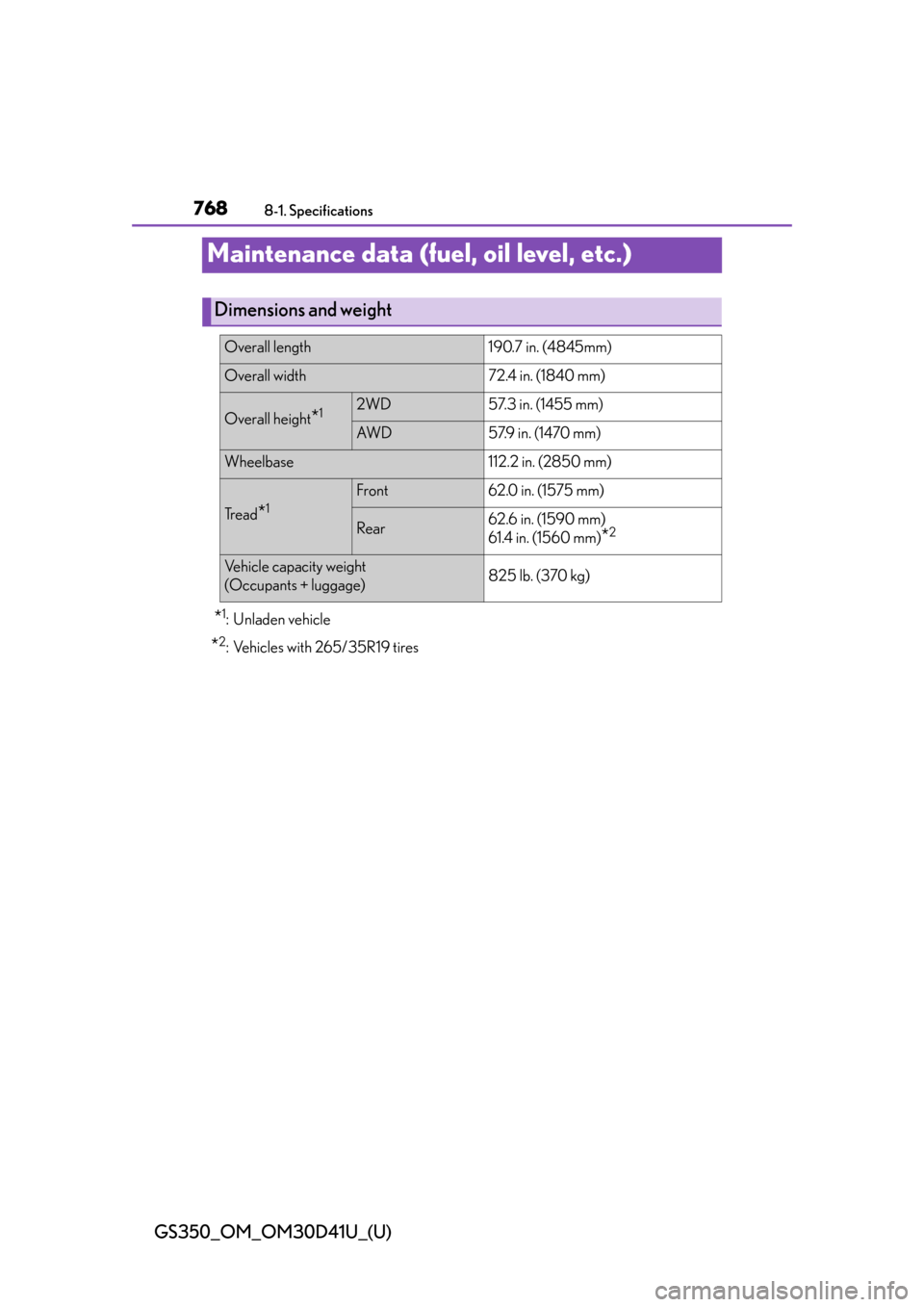
768
GS350_OM_OM30D41U_(U)
8-1. Specifications
Maintenance data (fuel, oil level, etc.)
*1: Unladen vehicle
*2: Vehicles with 265/35R19 tires
Dimensions and weight
Overall length190.7 in. (4845mm)
Overall width72.4 in. (1840 mm)
Overall height*12WD57.3 in. (1455 mm)
AW D57.9 in. (1470 mm)
Wheelbase112.2 in. (2850 mm)
Tr e a d*1
Front62.0 in. (1575 mm)
Rear62.6 in. (1590 mm)
61.4 in. (1560 mm)
*2
Vehicle capacity weight
(Occupants + luggage)825 lb. (370 kg)
Page 784 of 844
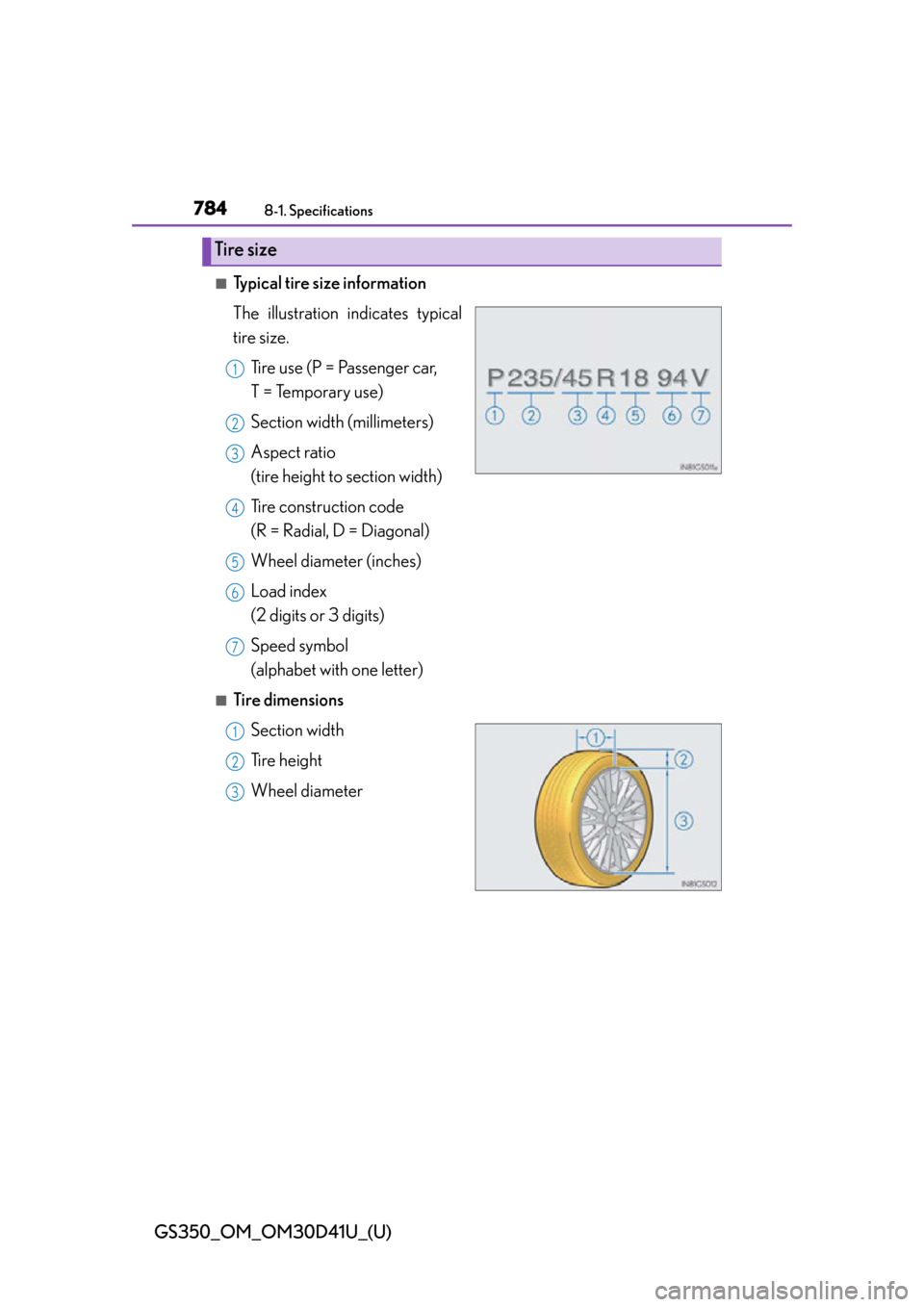
784
GS350_OM_OM30D41U_(U)
8-1. Specifications
■Typical tire size information
The illustration indicates typical
tire size.Tire use (P = Passenger car,
T = Temporary use)
Section width (millimeters)
Aspect ratio
(tire height to section width)
Tire construction code
(R = Radial, D = Diagonal)
Wheel diameter (inches)
Load index
(2 digits or 3 digits)
Speed symbol
(alphabet with one letter)
■Tire dimensionsSection width
Tire height
Wheel diameter
Tire size
1
2
3
4
5
6
7
1
2
3
Page 786 of 844

786
GS350_OM_OM30D41U_(U)
8-1. Specifications
This information has been prepared in accordance with regulations issued
by the National Highway Traffic Safety Administration of the U.S. Depart-
ment of Transportation.
It provides the purchasers and/or prospective purchasers of Lexus vehi-
cles with information on uniform tire quality grading.
Your Lexus dealer will help answer any questions you may have as you read this
information.
■DOT quality grades
All passenger vehicle tires must conform to Federal Safety Require-
ments in addition to these grades. Quality grades can be found where
applicable on the tire sidewall between tread shoulder and maximum
section width.
For example: Treadwear 200 Traction AA Temperature A
■Treadwear
The treadwear grade is a comparative rating based on the wear rate of
the tire when tested under controlle d conditions on a specified govern-
ment test course.
For example, a tire graded 150 would wear one and a half (1 - 1 /2) times as well
on the government course as a tire graded 100.
The relative performance of tires depends upon the actual conditions of their
use. Performance may differ significantly from the norm due to variations in
driving habits, service practices and differences in road characteristics and cli-
mate.
■Traction AA, A, B, C
The traction grades, from highest to lowest, are AA, A, B and C, and
they represent the tire’s ability to stop on wet pavement as measured
under controlled conditions on sp ecified government test surfaces of
asphalt and concrete.
A tire marked C may have poor traction performance.
Warning: The traction grade assigned to this tire is based on braking (straight
ahead) traction tests and does not include cornering (turning) traction.
Uniform Tire Quality Grading
Page 789 of 844
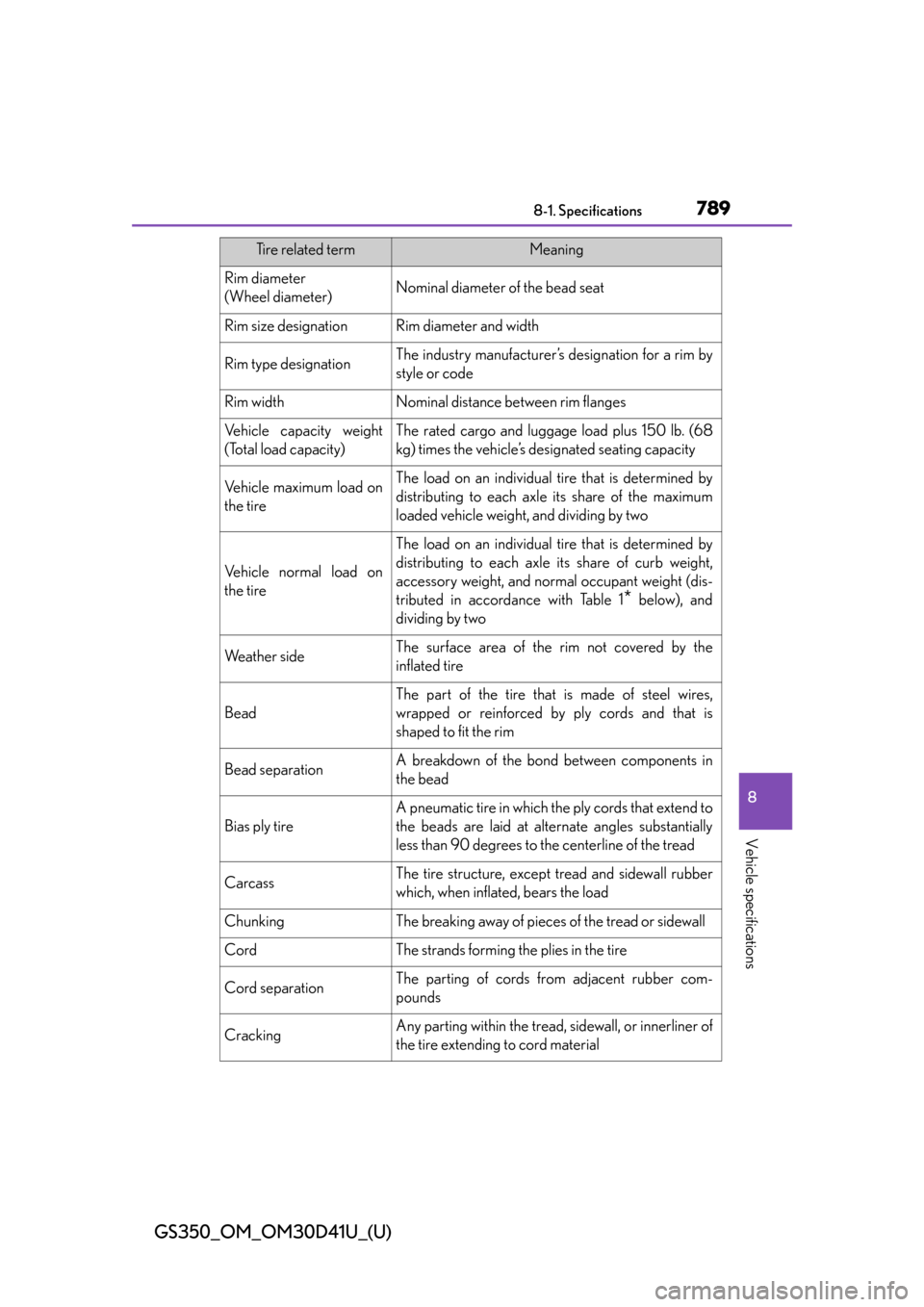
GS350_OM_OM30D41U_(U)
7898-1. Specifications
8
Vehicle specifications
Rim diameter
(Wheel diameter)Nominal diameter of the bead seat
Rim size designationRim diameter and width
Rim type designationThe industry manufacturer’s designation for a rim by
style or code
Rim widthNominal distance between rim flanges
Vehicle capacity weight
(Total load capacity)The rated cargo and luggage load plus 150 lb. (68
kg) times the vehicle’s designated seating capacity
Vehicle maximum load on
the tireThe load on an individual tire that is determined by
distributing to each axle its share of the maximum
loaded vehicle weight, and dividing by two
Vehicle normal load on
the tire
The load on an individual tire that is determined by
distributing to each axle its share of curb weight,
accessory weight, and normal occupant weight (dis-
tributed in accordance with Table 1
* below), and
dividing by two
We a t h e r s i d eThe surface area of the rim not covered by the
inflated tire
Bead
The part of the tire that is made of steel wires,
wrapped or reinforced by ply cords and that is
shaped to fit the rim
Bead separationA breakdown of the bond between components in
the bead
Bias ply tire
A pneumatic tire in which the ply cords that extend to
the beads are laid at alternate angles substantially
less than 90 degrees to the centerline of the tread
CarcassThe tire structure, except tread and sidewall rubber
which, when inflated, bears the load
ChunkingThe breaking away of pieces of the tread or sidewall
CordThe strands forming the plies in the tire
Cord separationThe parting of cords from adjacent rubber com-
pounds
CrackingAny parting within the tread, sidewall, or innerliner of
the tire extending to cord material
Tire related termMeaning
Page 791 of 844
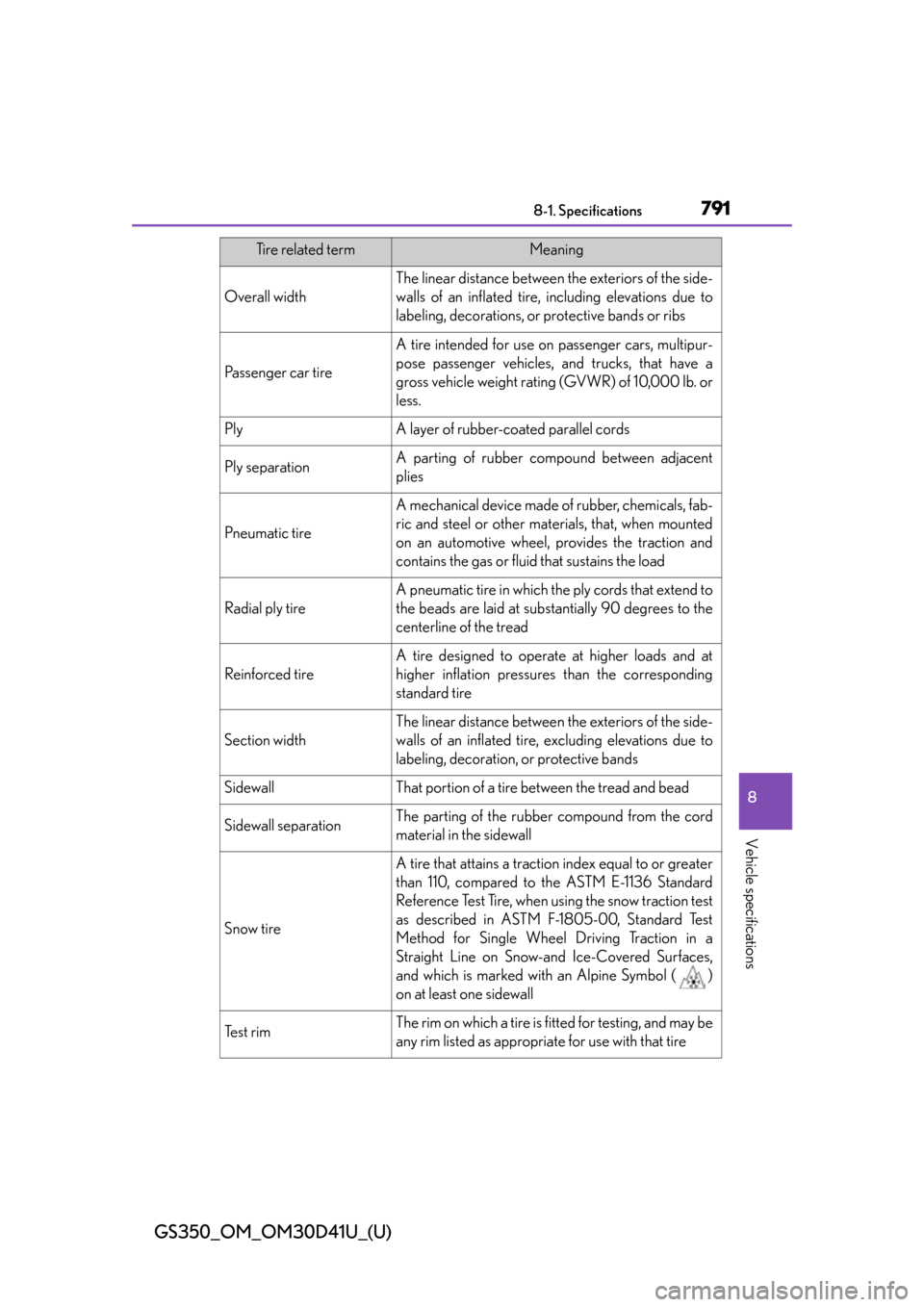
GS350_OM_OM30D41U_(U)
7918-1. Specifications
8
Vehicle specifications
Overall width
The linear distance between the exteriors of the side-
walls of an inflated tire, including elevations due to
labeling, decorations, or protective bands or ribs
Passenger car tire
A tire intended for use on passenger cars, multipur-
pose passenger vehicles, and trucks, that have a
gross vehicle weight rating (GVWR) of 10,000 lb. or
less.
PlyA layer of rubber-coated parallel cords
Ply separationA parting of rubber compound between adjacent
plies
Pneumatic tire
A mechanical device made of rubber, chemicals, fab-
ric and steel or other mate rials, that, when mounted
on an automotive wheel, provides the traction and
contains the gas or flui d that sustains the load
Radial ply tire
A pneumatic tire in which the ply cords that extend to
the beads are laid at substantially 90 degrees to the
centerline of the tread
Reinforced tire
A tire designed to operate at higher loads and at
higher inflation pressures than the corresponding
standard tire
Section width
The linear distance between the exteriors of the side-
walls of an inflated tire, excluding elevations due to
labeling, decoration, or protective bands
SidewallThat portion of a tire between the tread and bead
Sidewall separationThe parting of the rubber compound from the cord
material in the sidewall
Snow tire
A tire that attains a traction index equal to or greater
than 110, compared to the ASTM E-1136 Standard
Reference Test Tire, when using the snow traction test
as described in ASTM F-1805-00, Standard Test
Method for Single Wheel Driving Traction in a
Straight Line on Snow-and Ice-Covered Surfaces,
and which is marked with an Alpine Symbol ( )
on at least one sidewall
Te s t r i mThe rim on which a tire is fitted for testing, and may be
any rim listed as appropriate for use with that tire
Tire related termMeaning